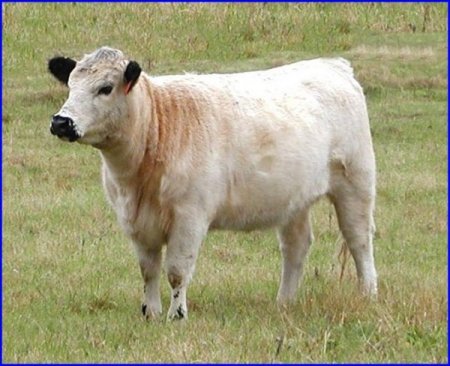In my opinion the above picture shows correct conformation of what a Top Quality British White or any other beef cow should look like.
This picture was taken 3/25/09 and the heifer had maintained this condition through the winter on grass and a little extra protein in the form of range cubes, about 3 pounds per day. I especially like her structure, straight lines, spring of rib, volume, depth of body and muscling.
Picture of above cow 18 months later with her first calf.
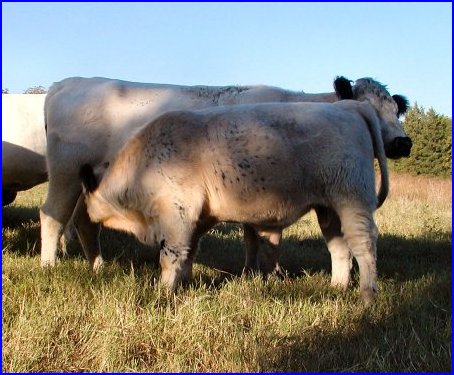
This picture was taken late afternoon 10/20/10. The bull calf is 7 months.
I estimate the calf’s weight to be about 600 pounds. Picture quality is not
good but it shows what kind of calf a good cow can raise.
~ ~ ~ ~ ~ ~ ~ ~ ~ ~
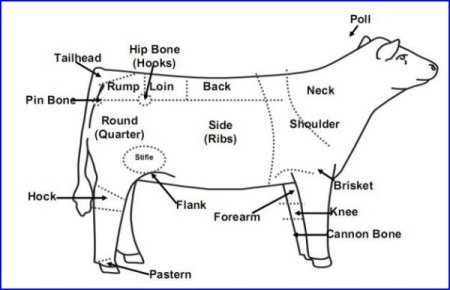
Body Parts Illustrated
|
This illustration names or describes the various parts of a beef animal. You should learn the terminology and learn to visually point out to yourself or others where each part is located on the animal. It will help you make an informed british white cattle selection decision. When making a selection of purebred British White Cattle for breeding purposes, pedigrees should be considered because they will assist you in detecting and identifying outstanding bloodlines and be of assistance in planning the mating and breeding programs. Selection for correct British White Cattle can get complex because you will want them to reproduce regularly over a long period of time, have enough vitality to maintain themselves in thrifty condition mainly on forages and produce calves and/or yearlings that have enough weight and quality to be profitable when sold. |
~ ~ ~ ~ ~ ~ ~ ~ ~ ~
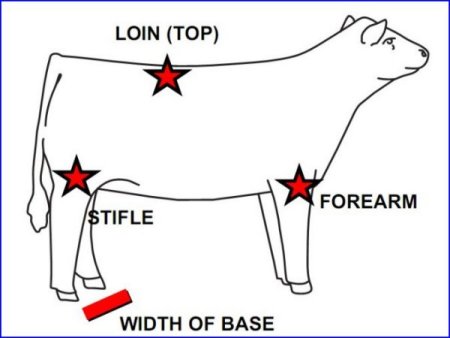
British White Cattle Muscling Areas Illustrated
| British White BULLS Long thick muscling is desired. It is indicated by the length and size (thickness, circumference) of the major muscles in the forearm, fullness and bulge of muscle in the stifle area above the rear flank, and the length, thickness and bulge of muscle in the round and down the top. Very thick, short, rounded extreme muscling in the shoulder and round, which hinders locomotion, gives “double muscled” appearance, and is usually not desired. British White FEMALES |
~ ~ ~ ~ ~ ~ ~ ~ ~ ~
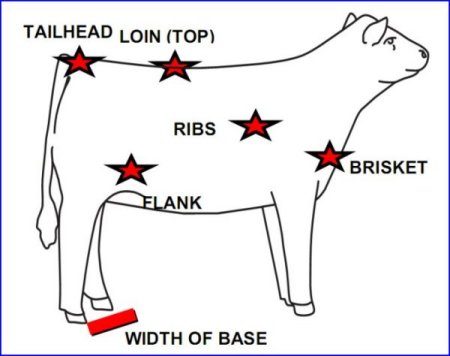
Areas to observe for fat deposits in determing the fat condition of
British White Cattle
|
The degree of finish or fat condition may vary depending on nutrient levels, parasites, season of year, and genotype and sex of the animal. Bulls should be trim with a thin even distribution of fat and not show excessive wasty deposits of fat, even when on high nutritive levels, or during the non breeding seasons. It may be detrimental to excessively fatten heifers or cows as they deposit excessive fatty tissue in their udder and around their reproductive organs which may result in decreased milk production and inefficient reproductive rates. Females will normally deposit more fat in the brisket, along the underline and over the ribs and back, than bulls. Cows and bulls in good flesh will winter cheaper and more efficiently than those who are poor doers and have little fleshing ability. |
~ ~ ~ ~ ~ ~ ~ ~ ~ ~
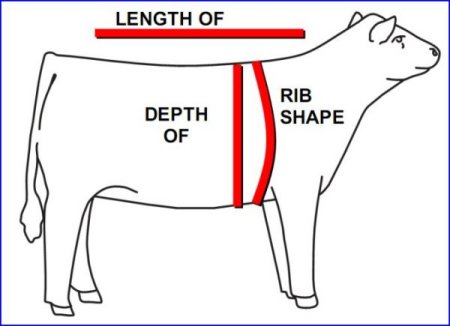
Areas to observe to determine Capacity and Volume of British White Cattle
|
Study this illustration well because you will want your British White Cattle to have adequate depth and width of body for efficient rapid growth and easy keeping ability. You will want to look for cows and heifers that look feminine with refined heads, long, narrow, clean necks; angular body shape with smooth shoulders and adequate body capacity. Compare the areas labeled in this illustration with the actual heifer shown at top of page; Length of Body, Depth of Body and Rib Shape (Spring of Rib). |
~ ~ ~ ~ ~ ~ ~ ~ ~ ~
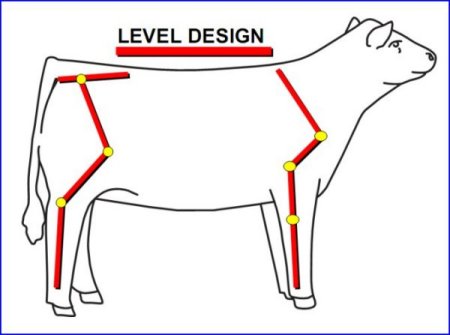
This illustration will help you visualize the correct internal structure
as you go about the selection of your British White Cattle.
|
Below is a short list of five things I recommend to get you started as you begin looking for areas to confirm the Structural Soundness of British White Cattle. |
~ ~ ~ ~ ~ ~ ~ ~ ~ ~
British White Cattle Society
Recommended Standards
|
The British White breed was first established in England. Listed below are Recommended Standards as published by the British White Cattle Society of England.
|
Click HERE for more Cattle Selection Information
~ ~ ~ ~ ~ ~ ~ ~ ~ ~

